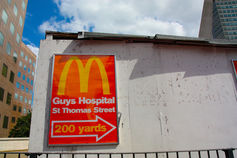
Flickr / Al King
Last month, a hospital in the UK announced it was closing it’s 20 year-old resident fastfood ‘restaurant’ and moving towards a food outlet more in-keeping with the role and responsibilities of the institution. Southampton General Hospital has housed a burger chain within its building for almost 2 decades but has now decided to not renew its lease as management felt it was more appropriate to have something “reflective” of the “healthcare environment.” Since the 1990s, patients and healthcare workers have been able to order junk food without leaving the hospital grounds. But in an age where most hospitals in many nations (including Australia, the UK and the USA) are now smoke-free, administrators felt high-fat, sugar and salt foods sold by a multinational with little interest in public health, were no longer acceptable.

This got me thinking about my hometown of Melbourne and our very own Royal Children’s Hospital. For many years (as long as I can remember), this institution of health and family has housed an American, multinational burger outlet too. Yet it has escaped the same pressures of society or management to change. In fact, most Melbournians will be well aware that despite a major, multi-billion dollar rebuild of the iconic tertiary health provider – the Golden Arches have found a brand new and updated home in the lobby of this new, shiny, publicly-funded institution. Between the clinic signs and ambulance bays sits the red and yellow branding as the smell of deep-fried fries waft into the entrance hall.
Now many will argue that sick children deserve to have burgers too and who are we to deny that opportunity or that these restaurants do offer “healthy choices”. Some might even argue that it is not our place to choose who we do and do not allow to rent out spaces in our public institutions.
For me though, the most concerning aspect of the whole situation is the continued overlooking of the issue altogether and the lack of a proper public debate. In a time when overweight and obesity, including childhood obesity, is rising – how is there not even much discussion over whether Ronald and his crew should be mixing with our patients and doctors – or what fallout this causes in our community.
So why is this a concern? What is the fallout? Well here are three reasons why McHospitals are not a good idea.
1. Symbolism
In 2014, the leading causes of global deaths are Non-Communicable Diseases including diabetes, cancers and heart disease and a leading risk factor for disease worldwide is unhealthy diet. So when a public hospital for children houses a fast food outlet in its lobby, this sends a mixed and unhelpful message to the community.
More so, to our kids.
Further than this though, is the halo effect that this situation creates. The credibility it lends the multinational cannot be underestimated.
2. Health
The second reason is probably the most important. We know that high fat, salt and sugar foods are linked with obesity and disease. We also know that soft drinks (a staple accompaniment in red and yellow meals) are linked with type 2 diabetes. In a publicly-funded institution charged with healing our most vulnerable and unwell children – how can we not see the potential health damage having these foods on-site could cause?
3. Economics
Finally, data from the Australian Diabetes, Obesity and Lifestyle study indicates the direct cost for overweight and obesity in 2005 was $21 billion. The same study estimated indirect costs of $35.6 billion per year. In a time of rising healthcare costs and ironically, hospital funding shortages, linking fast food with health in the minds of our population is as dangerous to our tightening belt as it is to our tightening budget.
At the micro level too, one can also imagine that treating patients in a tertiary institution who are then dining on foods that, at best, are unhelpful to the healing process, the economics of rental simply don’t stack up.
McFree?

Now once again, I am not saying we should ban or deny anyone anything. But there is strong symbolism (as well as potential health and economic consequences) in having fast food branding inside our most respected hospitals. Maybe it is just a matter of time, before McFree will be as accepted and expected as SmokeFree hospitals, but for now it concerns me that there is such a lack of discussion and concern.
McHospitals? I’m not lovin’ it.
Alessandro R Demaio does not work for, consult to, own shares in or receive funding from any company or organisation that would benefit from this article, and has no relevant affiliations.
